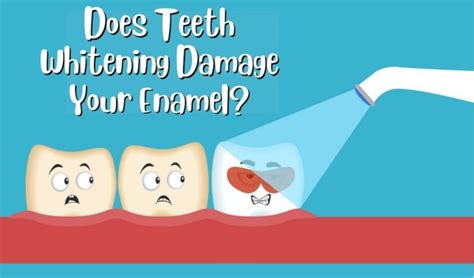Does Teeth Bleaching Damage Enamel

The quest for a brighter, more radiant smile has led many to explore teeth bleaching, also known as teeth whitening. While this cosmetic dental procedure can significantly enhance the appearance of one’s teeth, concerns about its impact on dental health, particularly on the enamel, are not uncommon. Enamel, the hardest substance in the human body, forms a protective layer over the teeth, shielding them from decay, sensitivity, and damage. Understanding the effects of teeth bleaching on enamel is crucial for making informed decisions about oral care and cosmetic treatments.
The Basics of Teeth Bleaching
Teeth bleaching involves the application of a chemical agent, typically hydrogen peroxide or carbamide peroxide, to the teeth. These agents penetrate the tooth enamel and break down the stains and discoloration within the dentin, a layer beneath the enamel, thus whitening the teeth. The concentration of these peroxides varies among different bleaching products, from over-the-counter (OTC) strips and trays to professional, in-office treatments.
Potential Effects on Enamel
The impact of teeth bleaching on enamel can vary depending on several factors, including the concentration of the bleaching agent, the method of application (at-home vs. professional), and individual tooth sensitivity. In general, when used as directed, most teeth bleaching products are considered safe and do not damage the enamel. However, there are potential risks and side effects to be aware of:
Tooth Sensitivity: One of the most common side effects of teeth bleaching is temporary tooth sensitivity. This occurs when the peroxide penetrates through the enamel to the dentin, reaching the nerves and causing sensitivity, particularly to cold or hot substances. While this sensitivity is usually reversible, it can be uncomfortable and may indicate that the enamel is slightly more permeable than usual.
Enamel Erosion: High concentrations of hydrogen peroxide or improper use of bleaching products can potentially weaken the enamel, making it more susceptible to erosion. Enamel erosion refers to the loss of enamel due to acid attacks, which can result from consuming acidic foods and drinks, among other factors. Although teeth bleaching itself does not directly cause erosion, it may exacerbate existing conditions if the enamel is already compromised.
Overuse and Abuse: Overusing teeth bleaching products or using them too frequently can lead to enamel damage. Following the recommended usage and concentration guidelines is crucial to minimizing risks to the enamel and overall dental health.
Mitigating Risks
To enjoy the benefits of teeth bleaching while preserving enamel health, consider the following precautions:
Professional Consultation: Before starting any teeth bleaching treatment, consult with a dental professional. They can assess the health of your teeth and gums, recommend the most suitable bleaching method for your situation, and guide you on how to maintain good oral health throughout the process.
Follow Instructions: Adhere strictly to the instructions provided with your bleaching product. This includes the recommended concentration of the bleaching agent, application time, and frequency of use.
Maintain Good Oral Hygiene: Regular brushing, flossing, and dental check-ups are essential for maintaining healthy teeth and gums. These practices help prevent issues that could be exacerbated by teeth bleaching.
Desensitizing Toothpaste: Using a desensitizing toothpaste before, during, and after bleaching can help minimize tooth sensitivity, a common side effect of the treatment.
Conclusion
While teeth bleaching is generally considered safe when used properly, it’s essential to approach the treatment with an understanding of its potential effects on enamel. By choosing the right products, following professional advice, and maintaining good oral hygiene practices, individuals can enjoy the aesthetic benefits of teeth bleaching while protecting their dental health. Remember, the key to safe and effective teeth bleaching lies in responsible use and adherence to guidelines, ensuring that the pursuit of a brighter smile does not compromise the integrity of your teeth.
Is teeth bleaching safe for everyone?
+Teeth bleaching is not recommended for everyone, particularly those with certain dental conditions such as gum disease, tooth decay, or exposed roots. Pregnant or breastfeeding women should also avoid teeth bleaching. It’s crucial to consult with a dental professional to determine if teeth bleaching is safe for your specific situation.
How often can I safely bleach my teeth?
+The frequency of teeth bleaching depends on the method used. For at-home products, it’s generally recommended not to bleach more than once every 6 months. Professional, in-office treatments can be done annually or as advised by your dentist, considering your oral health and the desired whitening effect.
Can I bleach my teeth if I have dental work like fillings or crowns?
+Teeth bleaching can be challenging if you have dental work such as fillings, crowns, or bridges. Bleaching agents do not affect these materials the same way they do natural teeth, which could result in uneven whitening. Consulting with a dentist is essential to discuss options and determine the best approach for your situation.


